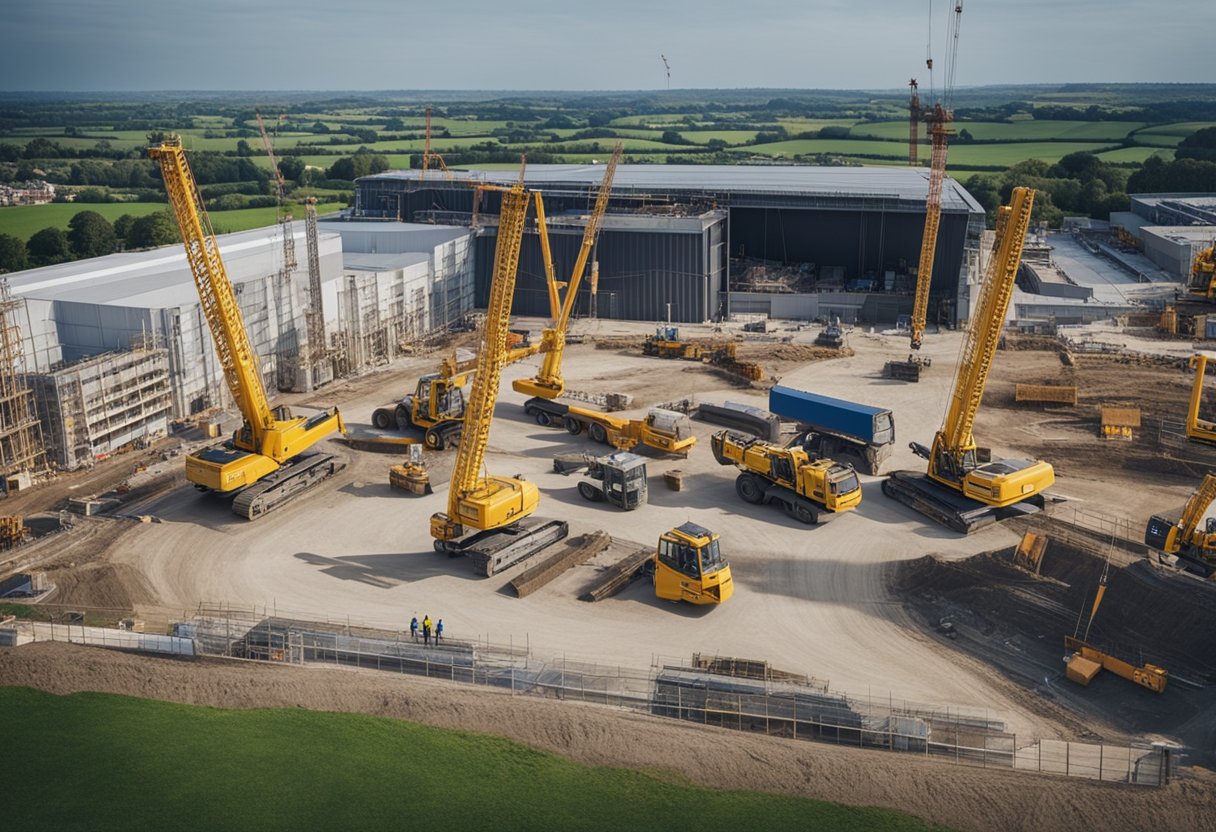The construction industry in the UK is bustling with significant developments shaping the landscape. Recent updates highlight major contract wins, technological advancements, and key political movements affecting the sector. With a growing focus on sustainability and modernisation, industry leaders are navigating the evolving demands and opportunities.

From substantial project awards to advancements in digital technology, the news in UK construction continues to evolve. Digital sign-ins and their impact, for example, have been noteworthy. Additionally, significant corporate movements, such as Lendlease’s decision to sell its UK construction arm, underscore the dynamic nature of the industry.
Professionals and enthusiasts need to stay informed with the most recent UK construction news. Keeping up with trends, contracts, and company performances is crucial for grasping the current climate and making informed decisions.
Key Takeaways
- Significant contract wins and technological advancements are shaping UK construction.
- Keeping updated with company performances and market trends is crucial.
- Political and corporate shifts are having a notable impact on the construction landscape.
Industry Overview

The construction industry in England features key players like leading contractors, significant market trends, and a complex regulatory environment. This section breaks down the essential elements shaping the sector.
Major Players
The English construction industry is dominated by some of the largest contractors in the UK. Industry leaders like Balfour Beatty, Kier Group, and Mace have a substantial market share. These companies often take on large-scale infrastructure projects, providing a significant portion of the sector’s value.
Specialist contractors also play a vital role. Firms such as Laing O’Rourke and ISG excel in niche markets like advanced manufacturing and digital construction. They bring innovative solutions to the table, particularly in digital sign-in and cyber security, as highlighted by recent industry news.
Market Trends
Recent data from April 2024 indicates a mixed outlook for construction activity. While main contract awards and detailed planning approvals have seen declines, there are pockets of growth. For example, HG Construction recently secured a £69 million project, reflecting some positive momentum amid broader challenges.
Digital technology is becoming more integrated, with an increase in cyber-attacks attributed to new digital sign-in methods. Additionally, sustainability remains a key theme, with more companies striving to meet green building standards and reduce their carbon footprints.
Regulatory Environment
The regulatory landscape for construction in England is multifaceted. Building regulations are highly stringent, requiring compliance with safety, environmental, and quality standards. Recent updates in building codes have focused on enhancing fire safety and sustainability.
The government also plays an active role in shaping the industry through policies and funding initiatives. The ongoing push for housing and infrastructure development often involves bureaucratic processes that contractors need to navigate. Firms must stay informed about these regulations to avoid delays and additional costs.
By understanding these major players, market trends, and regulatory challenges, stakeholders can better navigate the complexities of the English construction industry.
Significant Developments

The UK construction sector is seeing various transformative projects, ranging from infrastructure enhancements to urban regeneration. These developments promise to significantly impact the country’s landscape and economy.
Infrastructure Projects
One key project is the enhancement of the UK’s stock of crumbling schools. With an £11.4 billion repairs backlog, the fate of many schools is uncertain. Capital investment in education infrastructure is crucial to ensure safe and modern facilities for future generations.
Significant efforts are also being made in transport infrastructure, such as the Liverpool Street Station revamp. This £1.5 billion project aims to upgrade this iconic station, enhancing capacity and passenger experience.
The Oxfordshire Prison Scheme is another major development, focusing on building modern facilities to replace outdated structures. This will improve both the living conditions for inmates and the working environments for staff.
Commercial Ventures
Commercial construction is also witnessing substantial activity. One notable project is Hill’s Tottenham Hospital Redevelopment. This project aims to modernise the healthcare facilities while integrating commercial spaces that bring economic benefits to the region.
In the business hub sector, new office buildings and commercial spaces are being developed to meet the growing demand. These structures are designed with sustainability in mind, incorporating green technologies and eco-friendly materials.
Urban Splash House is contributing to the commercial sector by focusing on mixed-use developments that combine retail, office, and recreational spaces. These projects aim to revitalise urban landscapes and provide vibrant community areas.
Residential Construction
Residential construction is booming with several initiatives to address housing shortages. Homes England is spearheading numerous projects to deliver new homes across the country. Their focus is on developing affordable housing to meet the needs of diverse populations.
The regeneration schemes in urban areas are also facilitating the construction of new residential units. These projects aim to modernise old neighbourhoods and provide quality housing options.
Another notable development is the focus on sustainable housing. New builds are incorporating energy-efficient designs and renewable energy sources to promote environmental responsibility.
Regeneration Schemes
Regeneration schemes are transforming neglected urban areas into thriving communities. The emphasis is on improving infrastructure, housing, and public spaces to enhance the quality of life.
The Oxfordshire Prison Scheme also falls under this category, aiming to repurpose old prison sites for community use and development. This approach not only addresses overcrowding issues but also rejuvenates the local area.
In addition, the regeneration of older industrial areas is creating opportunities for new commercial and residential developments. These schemes often involve partnerships between the public and private sectors to maximise impact and sustainability.
Hill’s Tottenham Hospital Redevelopment is another key scheme, aiming to blend healthcare improvements with urban regeneration. This project will benefit both the local community and the wider city.
Business News

This section covers key updates in the business side of the construction industry in England. It includes major contract awards and financial analyses with a focus on accurate data.
Contract Awards
In recent months, construction companies have secured significant contracts. HG Construction won a £69 million project, showcasing their competitive edge. Another major contract went to Mace, who are expanding their portfolio amidst a vibrant market.
Notably, site wages saw a 7% rise, according to the Hays/BCIS Site Wage Cost Indices. This uptick indicates growing activity and demand for skilled labour. These contracts are crucial for maintaining momentum in the industry and ensuring project continuity.
Financial Analyses
Financial health of construction companies reflects the sector’s stability. Major players like Mace and HG Construction are seeing positive trends. Increased site wages, as reported by The Construction Index, suggest a robust market.
Election news, such as a Mace director running for Labour MP, brings potential regulatory impacts. Investors keep a close watch on such developments. Overall, the market shows resilience with continued investments and financial growth, indicating a positive outlook for the future.
Economic Impact

The construction sector in England is experiencing significant economic fluctuations. These changes affect both housing availability and employment within the industry.
Housing Crisis Response
England’s construction industry plays a critical role in responding to the housing crisis. Economic pressures, such as high inflation, have slowed down the pace of new housing projects. For instance, the headline CIPS construction PMI fell to 45.0 in September, indicating contraction. Despite these challenges, there are signs of stabilization due to falling inflation, which might encourage future investment.
Private industrial activity has increased, driven by the need for extra warehouse space. This shift highlights a demand for non-residential buildings that could affect housing availability. Contractors must balance their projects to ensure both commercial and housing demands are met.
Government initiatives aim to address housing shortages by setting apprenticeship targets for young workers. These programmes foster skills development, ensuring a steady flow of trained professionals into the sector. Meeting these targets is crucial for sustaining the future housing supply and mitigating the crisis.
Employment Dynamics
Employment in the construction sector has seen fluctuations, significantly impacted by economic conditions. Following the pandemic, there was a 3% fall in total construction employment in 2020, with self-employed workers experiencing an 11% decline. This has profound implications for project timelines and quality.
Apprenticeship programmes are essential to mitigate these employment challenges. They not only provide job opportunities but also ensure a skilled workforce for future projects. The sector’s ability to achieve apprenticeship targets is pivotal in maintaining a robust labour force.
Contractor failures, often due to financial instability, further strain employment figures. As some companies struggle, their workforce faces uncertainty, impacting overall industry productivity. Keeping employment dynamics stable is crucial for the sector to navigate through economic pressures and sustain growth.
In Depth Analysis

This section provides a detailed look at specific project case studies and the current challenges facing the construction sector in England. Key issues include supply chain disruptions, insurance concerns, and more.
Project Case Studies
Recent projects highlight the diverse nature of construction in England. For example, HG Construction is building a £69m build-to-rent scheme in Leeds. This project involves transforming a former car park into 375 homes, meeting the rising demand for rental properties.
Another case is the extensive use of fluctuation clauses in contracts to manage the volatile costs of materials like steel. These clauses help protect both contractors and clients from sudden price hikes. Additionally, the JCT Minor Works contract has been used effectively in smaller projects to ensure streamlined processes and clear terms.
Some projects also face unique challenges, such as managing flood risk in areas prone to heavy rainfall. Innovative drainage systems and elevated structures are often required to mitigate these risks, ensuring the safety and longevity of the construction.
Sector Challenges
The construction sector in England currently faces several challenges. Steel supply issues have disrupted project timelines, making it crucial to secure reliable suppliers and consider alternatives. The rising cost of materials has pushed many firms to negotiate fluctuation clauses to stabilise budgets.
Another significant challenge is attracting and retaining skilled labour. The industry needs continuous training and incentives to maintain a skilled workforce. Insurers are also becoming more cautious, especially in regions with high flood risk. This can lead to increased premiums and stricter coverage terms.
Firms must navigate these challenges while complying with regulations and maintaining project timelines. Adapting to these conditions requires flexibility and strategic planning to ensure success in the evolving construction landscape.
Apprenticeships

The construction sector in England is seeing varied trends in apprenticeship numbers. In early 2023, the number of apprenticeships in construction rose for the first time in six years, with about 26,100 new apprentices starting their careers. This was viewed as a positive development in the industry.
Yet, other reports indicate a mixed picture. For example, the number of construction apprenticeships in England saw a 6 per cent drop year-on-year as of February 2024. This decline suggests an ongoing struggle in maintaining consistent growth in apprenticeship starts.
In London specifically, the situation is more concerning. The number of construction apprenticeships has been falling for the past three years. This trend is worrying for a region that significantly contributes to the national construction output.
The Tory apprenticeship pledge was introduced to boost these numbers, aiming to provide more training opportunities within the sector. However, some industry insiders question whether this target-based approach might be harming the sector. Companies are finding themselves under pressure to meet these targets, sometimes facing financial penalties if they fail to fill apprenticeship vacancies.
Moreover, the concept of Employee Ownership Trusts (EOTs) is becoming more prominent. These trusts can improve employee engagement and retention, possibly making the sector more attractive to potential apprentices. Companies that have adopted EOTs report higher levels of employee satisfaction, which could translate into better apprenticeship outcomes.
News from the Councils and Planning Committees

Recent changes in planning and construction regulations have impacted several areas across England. These changes are designed to streamline processes and ensure that developments align with local needs.
Birmingham has seen new rules come into play. The city council now has more authority to hold developers accountable, ensuring projects meet community standards. This move is part of broader reforms giving councils new tools to manage rogue developers, enhancing local governance.
In Essex, planning committees are focusing on infrastructure improvements and affordable housing. Adjustments in developer payments to councils aim to better distribute the costs of development projects. This ensures that local infrastructure and housing can develop in tandem with new constructions.
A reduction in project approval times is a significant goal. Committees have recommended redesigning the planning system to grant permissions more quickly. This effort seeks to address delays and reduce the time from proposal to project completion, making construction processes more efficient.
COU (Change of Use) applications are also under scrutiny. Councils are refining processes to make it easier for property owners to change the use of their buildings. This flexibility supports adapting to new demands and re-purposing existing structures to better serve the community.
Funding issues are central to many councils, as highlighted by the County Councils Network. Financial pressures are prompting local authorities to find innovative solutions to support ongoing and future construction projects.
These updates indicate a focus on both improving the supply of affordable housing and enhancing infrastructure. Keeping track of such changes is crucial for anyone involved in the construction sector in England.
For more details, visit Construction News or GOV.UK.
Frequently Asked Questions

The UK construction industry is currently navigating through several challenges and changes. These include economic factors, key players in the market, legislative impacts, and predictions for future growth or declines.
What are the current major challenges faced by the housing construction sector in the UK?
The housing construction sector in the UK is facing significant issues due to economic conditions. Rising costs of materials and labour shortages are primary concerns. Additionally, obtaining planning permissions can be lengthy, slowing down development projects.
Which are the leading construction contractors in the United Kingdom today?
Some of the top construction contractors in the UK include Balfour Beatty, Kier Group, and Laing O’Rourke. These companies have secured major projects and are known for their extensive portfolios in the industry.
What is the status of the largest ongoing infrastructure projects in the UK?
Ongoing infrastructure projects like HS2, Crossrail, and the Thames Tideway Tunnel are progressing. HS2 is one of the most ambitious, aimed at improving rail connectivity between London and the North. Crossrail, also known as the Elizabeth line, is nearing full completion with phased openings.
How has recent legislation affected the UK construction industry?
Recent legislation, such as the Building Safety Act, has introduced stricter regulations to ensure safer building practices. This act came into effect to address concerns post-Grenfell Tower fire, enforcing higher standards and accountability in construction.
Has there been noticeable growth or decline in UK construction activity in recent times?
The UK construction industry experienced a decline of 18% in 2023, reflecting broader economic challenges. However, forecasts indicate a recovery with estimated growth of 12% in 2024, suggesting a potential rebound driven by new projects and investments.
What are the predicted trends for the UK construction market in the near future?
Future trends in the UK construction market include a focus on sustainability and green building practices. There is also an expected increase in the use of digital technologies and automation to improve efficiency and productivity within the sector.
For more detailed information on industry updates and forecasts, visit Latest UK Construction News.
